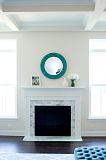Recently a friend and I went to the 'Twas the Night Before Christmas Celebration at the Westfield Heritage Village in Rockton, Ontario. It is held on three Saturday evenings before Christmas and was so much fun. You really feel transported back in time when you are walking around historic buildings at night with the fires burning and the lanterns lighting the way.
At the 'Twas the Night Before Christmas Celebration they use Christmas decorations for each of the buildings appropriate to the time period they are from. I found it really interesting to see how Christmas celebrations had changed through the years. The earliest buildings were from the beginning of the 1800s and the most recent were from the early 1900s. I have organized my photos in a somewhat chronological order so you can see the progression from the very simple natural decorations of the earliest homes to the vintage electric lights and glass balls of the more recent buildings.
I took lots of photos, but as the lighting was low in many of the buildings they were not as crisp as I would like when I didn't use flash and seemed a bit harsh when I did use flash. Although they aren't perfect, I still think you will get a taste of the different styles.
We began our walk through the village with the oldest buildings from the Georgian period, then visited some Victorian buildings, and finally some Edwardian buildings.
1) A Regency/Georgian Christmas (1800-1850):
I learned some interesting facts about Christmas in early Upper Canada:
- Only the German immigrants had Christmas trees in this time period. The immigrants from England, Scotland, and Ireland used 'greens' to decorate the windowsills, tables, and mantels in their homes.
- They often lived in small log cabins so only a few decorations were used.
- The early settlers did not have the traditional British greenery of holly and mistletoe available to them so they used things that were found in Ontario, such evergreen boughs and pine cones.
- Most decorations were made either from things they could gather from the woodland, such as pine cones and bittersweet berries, or were food items such as apples and nuts.
- Children were not the focus of Christmas at this time period and instead celebrations centred around adult community activities, such as wassailing or carolling from house-to-house.
- Twelfth night celebration were popular along with the story of Saint Nicholas.
- Stockings were hung by the fire or at the end of the beds and small treats were given at Christmas
There was a house and an inn from the Georgian period - both of which I loved for the simplicity of their decorations.
Bamberger House from 1810 (was the oldest home in Hamilton, Ontario when it was moved to Westfield Historic Village):
 |
| The tables, mantel, and windowsills were all decorated with evergreen boughs and red berries. |
 |
| I loved the beautiful blues and greens in this room along with the welcoming candle on the windowsill. |
D'Aubigny Inn from 1820:
 |
| The table was set with Christmas pudding and cookies and decorated with apples and a pineapple |
 |
| The pineapple would have been a special treat since it was imported. |
 |
| All the windows were adorned with swags of greenery and lanterns. |
 |
| I realize this tin lantern is not a Christmas decorations, but it was just so pretty I had to include it. |
2) A Victorian Christmas(1850-1900):
It was during this time period that many of the features of Christmas as we know it came into being. Here are some of the highlights:
- Prince Albert, Queen Victoria's husband who was German, introduced the Christmas tree to Great Britain, which in turn meant that it soon became popular in Canada as well.
- Decorations were still primarily from nature, such as pine boughs, pine cones, cranberries, popcorn, but more paper, lace, ribbon, and fabric decorations were also included.
- By the late Victorian period store-bought glass ornaments became available.
- Gifts were still usually homemade or simple, such as scarves, mitts, hankies, and wooden toys.
- Candy as well as cookies, and the traditional plum pudding and mincemeat pies were special treats for Christmas.
- Children became more of the focus of Christmas during the Victorian period.
The Victorian buildings had the type of homemade Christmas decorations that we now think of as very homey and traditional.
Tailor Shop:
 |
| The tree was decorated with felt gingerbread people, felt chains, straw and paper ornaments, and candles. |
 |
| A beautiful cut paper tree ornament. |
 |
| I loved the felt chains. |
Spinners and Weavers Shop:
 |
| There were crocheted faux popcorn balls hung from all the rafters and windows. They looked fantastic and made me wish I could crochet. |
 |
| I love how the popcorn swag was hung over the windows. |
 |
| The rag strips had been rolled into balls ready to be made into rugs, but I thought they looked very festive. |
|
|
Carpenter's Shop:
 |
| This little wooden toy was built in about 1880 and was donated to the museum by a local family. |
|
|
Cathcart School:
The school house was set up for children to make a Christmas craft. The volunteer in the school said in actual fact paper was so expensive in the Victorian time period that children would not have been using it for crafts, but they wanted something for the children who were visiting to make so they bent the rules. The schoolhouse was lovely with homemade decorations on the tree, lanterns on the desks, red paperdoll gingerbread swags across the tops of all the windows, and families busy making crafts.
 |
| The tree in the schoolhouse was decorated with yarn dolls, wooden clothes pin angels, and paper ornaments. |
 |
| Even the chalkboard looked festive with some greenery along the top. |
 |
| I loved the paperdoll chains across all the windows. |
 |
| A lovely arrangement of evergreens, pine cones, and fruit on the outside windowsills. |
 |
| The little sleigh that the children were making. |
 |
| My friend warming her hands by the lantern in the schoolhouse. |
McRoberts Dry Goods Store (being used as a dressmaker's shop):
The dressmaker's shop was from 1897, the late Victorian period, so there were a few modern touches, such as electric overhead lights and a Christmas catalogue. Anyone of a certain age in Canada remembers the Eaton's Christmas catalogue. I eagerly anticipated its arrival every year and remember pouring over all the pages of toys (and no I didn't read the one from 1897).
 |
| Some of the children's gowns in the dress-makers shop. |
 |
| Gorgeous buttons in a display case. |
 |
| The dressmaker's tree had spools of thread, paper chains, cranberry bead garlands, and some homemade decorations. |
 |
| A crocheted snowflake on the dressmaker's tree. |
 |
| Some dresses on display in the upstairs workroom of the dressmaker's shop. |
3) An Edwardian Christmas (1900-1925):
During this time period Christmas celebrations got more elaborate as electric Christmas tree lights and imported glass balls and decorations became more commonplace.
Gillen House:
Although the Gillen house was built in 1862, the furniture and decorations shown in the Heritage Village were from the Edwardian period. We were told that Mr. Gillen died soon after this house was built and so the Gillen House was lived in by Mrs Gillen and her four daughters. They were all musical and supported themselves by giving music lessons.
 |
| This was the first time period that showed Christmas crackers being used. |
 |
| The flower centerpiece of roses, pine boughs, and silver dollar plants - an unusual, but really pretty combination. |
 |
| A sweet little decoration hung in the kitchen. |
 |
| A corner of the Gillen House living room decorated with a nativity scene. |
 |
| The Christmas tree in the Gillen house living room with candles, paper fans, and glass balls. We were serenaded by Christmas carols on the violin. |
General store:
Although the store had electric overhead lights, the tree in the window had candles. I don't remember them saying so, but it looks to me like the tree is decorated with Union Jack flags because it is supposed to be WW1.
 |
| The general store tree decorated with flags, paper ornaments, glass balls, candles, and metal icicles. |
 |
| Candy for sale in the general store. Of course we had to try some. |
 |
| One of the wooden wind-up toys in the general store. |
Movie Theatre: There was a silent movie playing, fresh popcorn being made, and a Christmas tree in the window.
 |
| The Christmas tree in the window had large electric lights with metal reflectors, glass balls, and a metal garland. |
 |
| A close-up of the metal reflectors. |
Around the Village:
If you were a child the highlight of the village tour would definitely be a visit to the train station because not only could you have the station master send your letter to Santa via telegraph, but Saint Nick himself was in the caboose. How fun would that be?
 |
| The engine was decked out for Christmas with some greenery on the front. |
This train station was used in the filming of the Anne of Green Gables movie and the TV series Road to Avonlea.
 |
| Children waiting in the train station to have their letters sent to the North Pole. |
 |
| Looking through the window at the Station Master getting ready to send a Santa letter to the North Pole. |
It was a perfect evening with cool crisp air, stars overhead, and the scent of fire in the air. We had a wonderful time looking through historic buildings that spanned over one hundred years and, of course, then had to have a bite to eat and a look through the gift shop.
I loved so many of the decorations and ideas, but I think the earliest time periods were particularly appealing. What time period is your favourite?




































































.png)



















































































































































.jpg)



















































































.jpg)



























WHat a glorious little trip this must have been. And you documented it so well with such lovely photos. Thanks for sharing it with us. I do see such beauty in the simpler, early times. And those fashions and the baby's christening gown just make my heart flutter!
ReplyDeleteHappy Holidays!
Big TX Hugs,
Stephanie
Angelic Accents
What a fun trip, Grace! Thanks so much for sharing your pictures and all you learned with us. I think I liked the Victorian era best because that's when Prince Albert introduced the Christmas tree to England and then the tradition crossed the pond :D
ReplyDeleteI thought the crocheted popcorn garland was too cute. I would love to learn to make one for our tree.
This post has helped get me into the Christmas spirit!!!
Oh how fun this must have been. I actually like several things from each time period which kind of matches what the different kinds of things I like now. That crocheted popcorn garland is wonderful. I really like that. I would love to have that blue chalkboard and the mail organizer from the mail station. What treasures!
ReplyDeleteThe photos was so great you could feel the Christmas spirit just by looking at the photos :-)
ReplyDeleteYou know, I like the earlier periods. There seemed to be less focus on all the 'stuff' and more on the activities. Reading all this makes me thing we've strayed somewhat in the ways we celebrate now.
ReplyDeleteThis was really interesting, and I enjoyed the pictures a lot, even though they weren't perfect. Thanks for the post!
My goodness! I would've loved to have gone to this! Thank you for all the photos.
ReplyDeleteGreat photos, and thanks for sharing your evening and the interesting facts. We go to Rockton for the fair, but I didn't know they have all this! We love Black Creek Pioneer Village and have even been to Upper Canada Village several times so I'll have to put this on my list of 'must do's'. Thanks for sharing.
ReplyDeleteThis is a beautiful post! Thanks so much for sharing it with us!
ReplyDelete